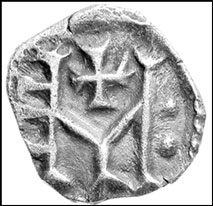 Silver penny minted around 660AD
Silver penny minted around 660ADThe 5th century collapse of the Roman Empire in western Europe began a slow decline in the monetary economy. During Roman times the western provinces had a robust money-based economy with the regular introduction of gold, silver and bronze coins from various mints. Much of the circulation was prompted by payments to soldiers, factories supplying the legions, and the massive bureaucracy created by 4th century emperors.
For more on the end of the Western empire read Belisarius Enters Rome, and the Life of St Severinus.
With the empire gone, most mints closed, payments to soldiers ceased, the bureaucracy gone, and trade declined. Bartering and payments in kind became more common. Gold coins still circulated and indeed into the early 7th century the Frankish kings received subsidies in the form of gold coins from the Byzantine empire. However, with the great Persian War (602-628) rapidly followed in the 630s and 640s by the Muslim conquest of the most prosperous Byzantine provinces, the Frankish subsidies ceased. For more on the travails of the Eastern Empire read A Great War.
It has been known for some time that silver coins began to appear to replace the more scarce gold coins. Their lesser value and more availability allowed for more use in commerce and helped the slow revival of Western Europe's economy. What remained unknown was the source of the silver. Scholars speculated that much of it came from Roman bullion that had been melted down and recast or imported from the Mediterranean. A 2018 paper, published in the journal Antiquity, may provide an answer.
Using lead analysis of ice cores, the authors pinpointed a mining complex, located at Melle (near the modern town of Deux-Sevres), in Western France, as the source of the silver, beginning in the period between 640 and 670. Lead levels are key because silver is derived from lead ores. We've already learned much about the lead industry during Roman times as elevated levels of lead have been found in ice cores dating back to the early centuries AD in ice sheets in Greenland and the Alps. Lead levels collapsed with the end of the Western Empire, taking centuries to rise again to similar levels. However, even during the gap centuries, lead levels varied and scientists using analytical tools and prevailing winds have been able to identify specific lead sources, including the Melle mines.
The authors were able establish the mid-7th century dating from the Alpine ice cores by calibrating the cores with three other known events - the total collapse in lead pollution at the time of the Blakc Death from 1349-53, the increase in bismuth levels with the gigantic series of eruptions from an Icelandic volcano between 934 and 939, and the identifiable markers from the great eruption of 536 (for more on the last event read The Big Sleepy Chill).
The existence of the Melle mines have been known for some time and during the 9th and 10th centuries they provided large amounts of coins to the Frankish kingdom during the time of Charlemagne and his immediate successors. The 2018 paper establishes they were the original source for the transition from gold to silver, enabling Frankish mints to initially produce gold coins alloyed with silver and subsequently switching to all silver coins within a quarter century.
And now we understand event in the revival of the West.

No comments:
Post a Comment